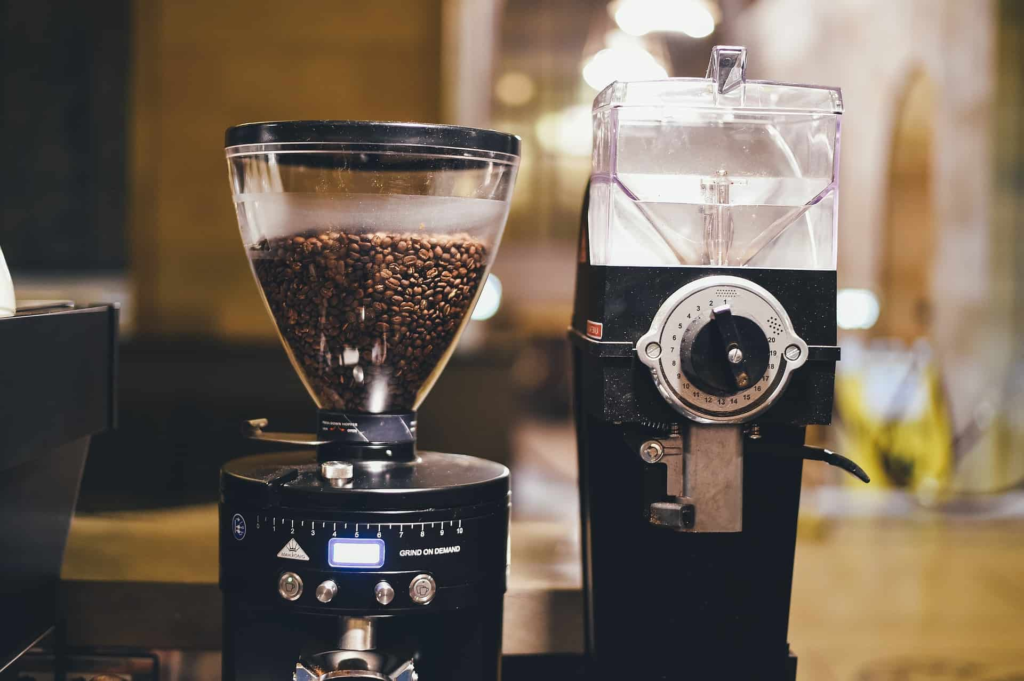The coffee grinder is a cornerstone of the home barista’s arsenal, transforming whole coffee beans into the perfect grounds for a truly exceptional cup of coffee. Whether you’re a seasoned enthusiast or just starting your coffee journey, understanding the nuances of coffee grinders can significantly elevate your brewing experience. This article will explore the different types of grinders, their key features, and how to choose the right one for your needs.
Understanding the Importance of Grinding Your Beans
Freshly ground coffee beans release their full flavour potential, offering a richer, more aromatic, and more nuanced cup than coffee that has already been ground. Because pre-ground coffee is exposed to air and light, it soon loses its freshness, making the brew stale and less flavorful.
Types of Coffee Grinders
Blade Grinders: These grinders cut beans into smaller pieces by revolving a blade.
Pros: Affordable and easy to use.
Cons: Produces uneven grind sizes, leading to inconsistent extraction and a less-than-ideal cup. Can overheat beans, affecting flavour.
Burr Grinders: These grinders use two grinding surfaces (burrs) to crush the beans between them, resulting in a more consistent grind size.
Pros: Produce a more even grind size, leading to better extraction and a more consistent flavour. Less likely to overheat beans.
Cons: Generally more expensive than blade grinders.
Burr Grinder Types

Conical Burr Grinders: Use conical burrs that grind the beans between two cones. Often considered the most precise and consistent grinders, but can be slower than flat burr grinders.
Flat Burr Grinders: Use flat, circular burrs that grind the beans between two plates. Generally faster than conical burr grinders and can handle larger volumes of beans.
Key Features to Consider
Grind Size Adjustment: Look for a grinder with a wide range of adjustable grind sizes. This will allow you to achieve the ideal grind for different brewing methods (e.g., espresso, pour over, French press).
Grind Consistency: Ensure the grinder produces a consistent grind size to ensure even extraction.
Speed: Consider the speed of the grinder, especially if you grind large quantities of coffee regularly.
Ease of Use: Look for a grinder that is easy to clean and maintain.
Noise Level: Some grinders can be quite noisy. Consider the noise level if you plan to grind coffee early in the morning or late at night.
Durability: Invest in a well-built grinder that will last for years to come.
Choosing the Right Grinder for You
Brewing Methods: Consider the brewing methods you primarily use. Espresso requires a very fine grind, while French press requires a coarser grind.
Budget: Set a budget and choose a grinder that fits within your price range.
Space Considerations: Consider the size and weight of the grinder, especially if you have limited counter space.
Coffee Grinder Trends
Smart Grinders: Smart grinders connect to your home network or a mobile app, allowing you to control grind settings, save custom profiles, and even monitor bean usage remotely.
Sustainability: Increasingly, consumers are looking for grinders made from sustainable materials and manufactured with eco-friendly practices.
Aesthetic Appeal: Coffee grinders are becoming more aesthetically pleasing, with sleek designs and high-quality finishes that complement modern kitchens.
Metaverse Considerations
While still in its early stages, the Metaverse could offer unique opportunities for coffee grinders. Imagine a virtual coffee shop where you can use a virtual grinder to create your custom blend, adjusting grind size and bean type to your exact preferences.
FAQs
What is the difference between a stepped and a stepless grinder?
Stepped grinders have a set number of grind settings, while stepless grinders allow you to adjust the grind size to any degree. Stepped grinders are easier to use, but stepless grinders offer more control over the grind size.
What grind size should I use for my coffee?
The grind size you need will depend on the brewing method you are using. For example, you will need a finer grind for espresso than you will for drip coffee.
Espresso: Fine grind
Moka pot: Fine grind
Pour-over: Medium grind
Drip coffee: Medium-coarse grind
French press: Coarse grind
Cold brew: Coarse grind
How long will my coffee beans stay fresh after grinding?
Coffee beans start to lose their flavour and aroma as soon as they are ground. Once ground, coffee beans are best used within 30 minutes.
How can I clean my coffee grinder?
It is important to clean your coffee grinder regularly to remove any coffee oils that can build up and affect the taste of your coffee. You can clean your grinder by grinding a few tablespoons of fresh coffee beans or using a special cleaning brush.
What are the latest trends in coffee grinders?
Smart grinders: Smart grinders can be connected to your smartphone and allow you to control the grind size and brewing time remotely.
Single-dose grinders: Single-dose grinders are designed to grind just the right amount of coffee for a single cup of coffee.
Nitro grinders: Nitro grinders are used to grind coffee beans for cold brew coffee that is infused with nitrogen gas. This creates a creamy, frothy coffee with a cascading effect.
Final Thoughts
Investing in a high-quality coffee grinder can significantly enhance your coffee-drinking experience. By understanding the different types of grinders and their key features, you can choose the perfect grinder for your needs and enjoy the rich, flavourful rewards of freshly ground coffee.
To read more, Click here

Leave a Reply